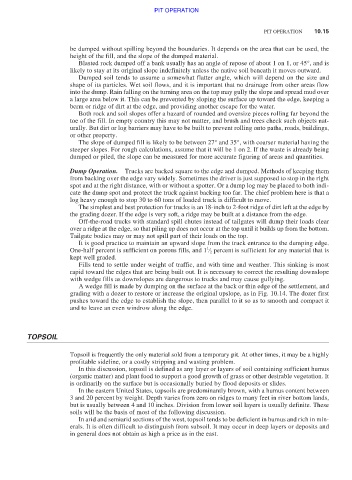Page 509 - Moving the Earth_ The Workbook of Excavation
P. 509
PIT OPERATION
PIT OPERATION 10.15
be dumped without spilling beyond the boundaries. It depends on the area that can be used, the
height of the fill, and the slope of the dumped material.
Blasted rock dumped off a bank usually has an angle of repose of about 1 on 1, or 45°, and is
likely to stay at its original slope indefinitely unless the native soil beneath it moves outward.
Dumped soil tends to assume a somewhat flatter angle, which will depend on the size and
shape of its particles. Wet soil flows, and it is important that no drainage from other areas flow
into the dump. Rain falling on the turning area on the top may gully the slope and spread mud over
a large area below it. This can be prevented by sloping the surface up toward the edge, keeping a
berm or ridge of dirt at the edge, and providing another escape for the water.
Both rock and soil slopes offer a hazard of rounded and oversize pieces rolling far beyond the
toe of the fill. In empty country this may not matter, and brush and trees check such objects nat-
urally. But dirt or log barriers may have to be built to prevent rolling onto paths, roads, buildings,
or other property.
The slope of dumped fill is likely to be between 27° and 35°, with coarser material having the
steeper slopes. For rough calculations, assume that it will be 1 on 2. If the waste is already being
dumped or piled, the slope can be measured for more accurate figuring of areas and quantities.
Dump Operation. Trucks are backed square to the edge and dumped. Methods of keeping them
from backing over the edge vary widely. Sometimes the driver is just supposed to stop in the right
spot and at the right distance, with or without a spotter. Or a dump log may be placed to both indi-
cate the dump spot and protect the truck against backing too far. The chief problem here is that a
log heavy enough to stop 30 to 60 tons of loaded truck is difficult to move.
The simplest and best protection for trucks is an 18-inch to 2-foot ridge of dirt left at the edge by
the grading dozer. If the edge is very soft, a ridge may be built at a distance from the edge.
Off-the-road trucks with standard spill chutes instead of tailgates will dump their loads clear
over a ridge at the edge, so that piling up does not occur at the top until it builds up from the bottom.
Tailgate bodies may or may not spill part of their loads on the top.
It is good practice to maintain an upward slope from the truck entrance to the dumping edge.
1
One-half percent is sufficient on porous fills, and 1 ⁄ 2 percent is sufficient for any material that is
kept well graded.
Fills tend to settle under weight of traffic, and with time and weather. This sinking is most
rapid toward the edges that are being built out. It is necessary to correct the resulting downslope
with wedge fills as downslopes are dangerous to trucks and may cause gullying.
A wedge fill is made by dumping on the surface at the back or thin edge of the settlement, and
grading with a dozer to restore or increase the original upslope, as in Fig. 10.14. The dozer first
pushes toward the edge to establish the slope, then parallel to it so as to smooth and compact it
and to leave an even windrow along the edge.
TOPSOIL
Topsoil is frequently the only material sold from a temporary pit. At other times, it may be a highly
profitable sideline, or a costly stripping and wasting problem.
In this discussion, topsoil is defined as any layer or layers of soil containing sufficient humus
(organic matter) and plant food to support a good growth of grass or other desirable vegetation. It
is ordinarily on the surface but is occasionally buried by flood deposits or slides.
In the eastern United States, topsoils are predominantly brown, with a humus content between
3 and 20 percent by weight. Depth varies from zero on ridges to many feet in river bottom lands,
but is usually between 4 and 10 inches. Division from lower soil layers is usually definite. These
soils will be the basis of most of the following discussion.
In arid and semiarid sections of the west, topsoil tends to be deficient in humus and rich in min-
erals. It is often difficult to distinguish from subsoil. It may occur in deep layers or deposits and
in general does not obtain as high a price as in the east.

